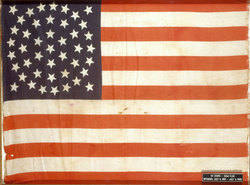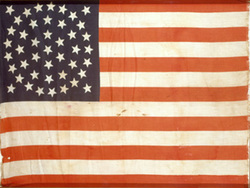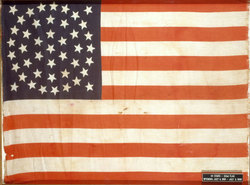The forty-four star flag, recognizing Wyoming's entry into the Union on July 10th, 1890 and official on July 4th, 1891, was the last flag commercially manufactured bearing the concentric ring star pattern that became popular during the American Civil War.
Triple ring pattern.
The field of this noteworthy flag consists of thirteen horizontal alternating red and white stripes, beginning and ending with red. The upper, hoist corner, extending through the seventh stripe from the top is a dark blue canton, (--- inches wide by ----inches high on the hoist), and bears forty-four white, 5 pointed stars, each (--- inches) across their points. These stars are (printed??- appliqued???) and are arranged in three concentric rings around a center star. The inner most ring displays six stars, the middle ring twelve stars, and the outer ring twenty-one stars. An additional star decorates each corner of the canton. Date: 1891-1895.
Superior Court Judge John T. Ball, of Santa Clara County, California, acquired this flag. Framed (outside dimensions x ).
Exhibition History
First Presidio Exhibit
(ZFC0597)
44-STAR UNITED STATES FLAG (CONCENTRIC RING PATTERN)
Date: 1891-1895
Medium: Printed on cotton
Comment: This flag displays its stars in three concentric rings around a center star of the same size. The inner ring bears six stars, the middle ring twelve, and the outer ring twenty-one. Four other stars, one in each corner, bring the total to forty-four stars. This pattern dates to the American Civil War, when the Philadelphia flag contractors submitted flags of that star pattern to the Quartermaster department, first on the swallowtail guidons that they had reworked from the old red over white pattern that were adapted to the new pattern and then with the national colors provided on contract. At least one Baltimore maker followed suit and continued to do so at least into the third quarter of the nineteenth century. The maker of these well printed flags, is, as of yet, not known.
Provenance: Acquired by the Zaricor Flag Collection (ZFC0597) in 2000 from the collection of Judge John T. Ball of San Jose, CA.
Second Presidio Exhibit, 2003 - GALLERY VI
(ZFC0597)
44-Star United States Flag, Concentric Ring Pattern
Date: 18911895 44 Stars: July 4, 1891-July 3, 1896 (Wyoming statehood July 10, 1890)
Medium: Printed cotton
Comment: This flag displays its stars in three concentric rings around a center star of the same size. The inner ring bears six stars, the middle ring twelve, and the outer ring 21. Four other stars, one in each corner, bring the total to 44 stars. The concentric ring pattern dates to the American Civil War, when Philadelphia flag contractors submitted flags of that star pattern to the Armys Quartermaster Department. The concentric rings appeared first on the swallowtailed guidons that had been reworked from old stock and then on the national colors provided under contract. At least one Baltimore maker followed suit and continued to make such flags at least into the third quarter of the 19th century. The maker of these well-printed flags is not yet known.
Provenance: Acquired by the Zaricor Flag Collection (ZFC0597) in 2002 from the collection of Judge John T. Ball of San Jose, CA.
Publication History:
Madaus, Howard M., Dr, Whitney Smith, The American Flag: Two Centuries of Concord and Conflict. Santa Cruz: VZ Publications, 2006, p. 106-107.
44-Star United States Flag Concentric Ring Pattern
This flag displays its stars in three concentric rings around a center star of the same size. The inner ring bears six stars, the middle ring twelve, and the outer ring 21. Four other stars, one in each corner, bring the total to 44 stars. The concentric ring pattern dates
to the Mexican War. Later, during the Civil War, Philadelphia flag contractors submitted flags of that star pattern to the Armys Quartermaster Department.
The concentric rings appeared first on the swallowtailed guidons that had been reworked from old stock and then on the national colors provided under contract. At least one Baltimore maker followed suit and continued to make such flags at least into the
third quarter of the 19th century. The maker of these well-printed flags is not yet known. Its design is one of the latest known use of the concentric rings star pattern in the U.S. flag design, which represents the end of an era of the use of the stars in a circular
constellation. Under the 44-star Stars & Stripes, Benjamin Harrison finished his term of office as president and Grover Cleveland served in the White House for his second, non-consecutive, term.
Date: 1891 1895
Size: 26.5" hoist x 44" fly
44 Stars: July 4, 1891 July 3, 1896 (Wyoming statehood July 10, 1890)
Medium: Printed cotton
Provenance: Acquired by the Zaricor Flag Collection in 2002 from the collection of Judge John T. Ball
of San Jose, CA.
ZFC0597
ZFC Noteworthy Flag
Item is Framed




